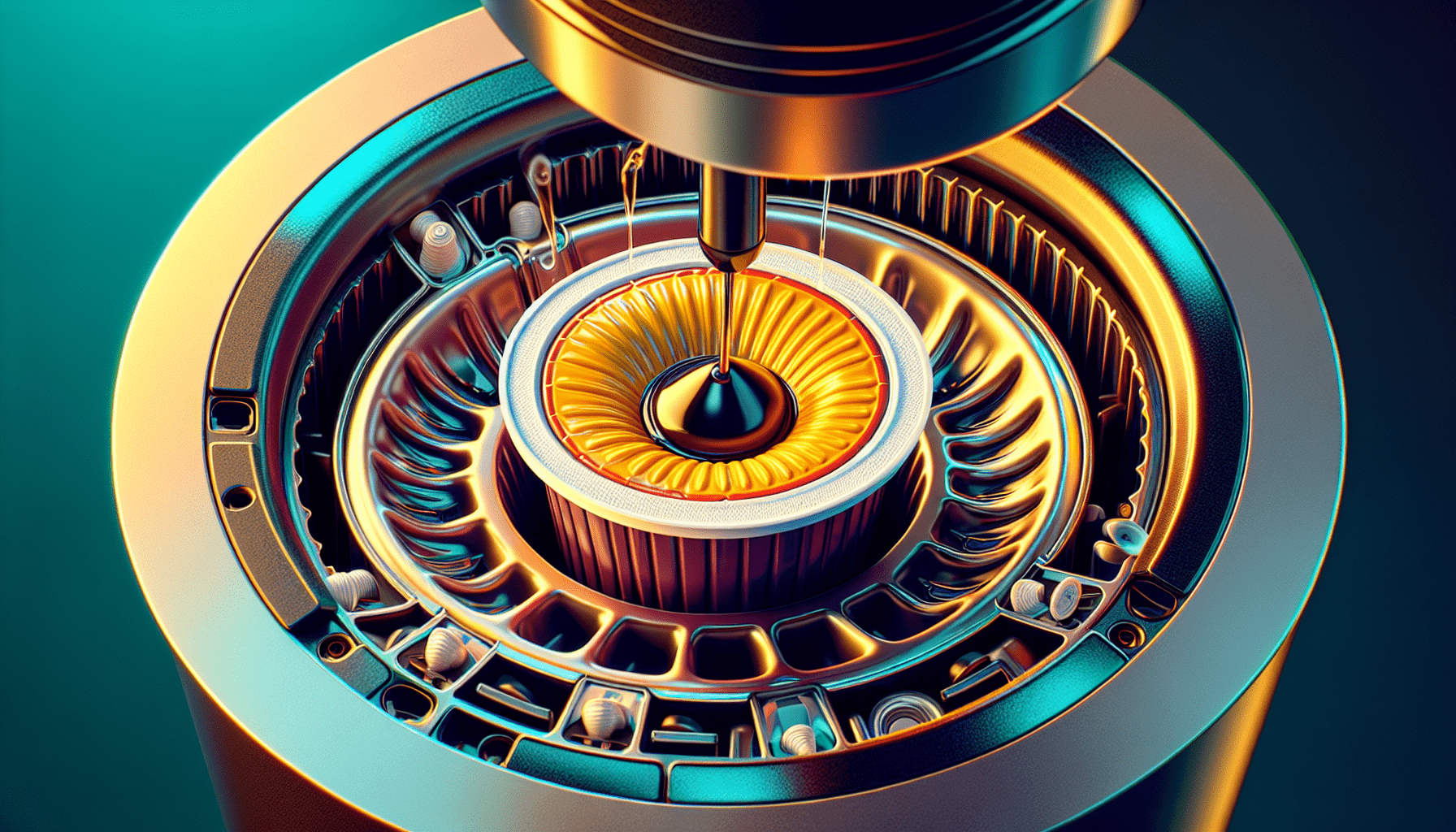If you’re a coffee lover, chances are you have come across the popular K-cup coffee makers. But have you ever wondered how they actually work? With their convenient single-serve pods, these machines have revolutionized the way we brew our daily cup of joe. In a nutshell, a K-cup coffee maker uses a combination of hot water and pressure to quickly extract the flavor from the coffee grounds within the pod. So, if you’re curious to uncover the mystery behind these magical machines, read on to discover the inner workings of a K-cup coffee maker.
Overview of K-cup Coffee Maker
A K-cup coffee maker is a convenient and quick way to brew a single cup of coffee. It has gained popularity in recent years due to its ease of use and versatility. This article will provide a comprehensive look into how a K-cup coffee maker works, the components involved, the brewing process, and the advantages and disadvantages of using one. Whether you are a coffee aficionado or just someone who enjoys a good cup of joe, understanding how a K-cup coffee maker operates can help you make informed decisions about your coffee brewing methods.
Brief history of K-cup coffee makers
K-cup coffee makers were first introduced by the company Keurig in the late 1990s. The concept was to provide a convenient and mess-free way of brewing coffee using pre-packaged single-serve pods. Keurig’s K-cup system quickly gained popularity, and other coffee companies followed suit by producing their own versions of the pods. Today, K-cup coffee makers have become a common sight in homes, offices, and even cafes.
Components of a K-cup coffee maker
To understand how a K-cup coffee maker works, it is essential to familiarize yourself with its components. The main parts of a K-cup coffee maker include a water reservoir, heating element, brew chamber, pump, pressure control valve, and a drip tray.
Water Heating Process
The water heating process is a critical step in brewing the perfect cup of coffee with a K-cup coffee maker. It involves heating the water to the optimal temperature for extracting the flavors from the coffee grounds.
Water reservoir and heating element
K-cup coffee makers typically have a water reservoir located at the back or side of the machine. This reservoir holds the water that will be used to brew the coffee. The heating element, usually a high-wattage electric coil, is responsible for heating the water to the desired temperature. Once the water is heated, it is ready to be used for brewing.
Temperature control
Maintaining the correct water temperature is crucial for extracting the best flavors from the coffee grounds. Most K-cup coffee makers are equipped with temperature control mechanisms that ensure the water remains at the ideal brewing temperature throughout the brewing process. This temperature control plays a significant role in delivering a consistently satisfying cup of coffee.
Brewing Process
The brewing process in a K-cup coffee maker involves several steps that work together to transform coffee grounds into a flavorful and aromatic beverage.
Inserting a K-cup into the machine
To start the brewing process, you simply need to insert a K-cup into the designated chamber of the coffee maker. K-cups are small plastic cups containing pre-measured amounts of ground coffee sealed with a foil lid. They come in a wide variety of flavors, strengths, and coffee brands, allowing you to choose your preferred coffee type for each cup.
Piercing the K-cup
Once the K-cup is inserted into the machine, the brew chamber is closed, and the machine pierces the foil lid of the cup. This puncturing allows hot water to flow into the K-cup, interacting with the coffee grounds and extracting the flavors.
Water injection and extraction
As the brew chamber is sealed, hot water is injected into the K-cup under pressure. The water passes through the coffee grounds, dissolving and capturing the coffee’s essential oils, flavors, and aromas. The result is a freshly brewed cup of coffee with a rich and satisfying taste.
Brewing time
The brewing time can vary depending on the coffee maker model and personal preferences. On average, it takes approximately one to two minutes for a K-cup coffee maker to complete the brewing process. The machine often indicates when the brewing is complete, either through an audible signal or LED indicator.
Pressure and Extraction
Pressure and extraction are key factors in the brewing process of a K-cup coffee maker.
Importance of pressure
The pressure applied during the brewing process plays a crucial role in extracting the optimal flavors from the coffee grounds. The hot water being injected into the K-cup is pressurized to achieve a thorough extraction of the coffee’s flavors. The pressure helps to ensure that every sip of coffee is robust and full-bodied.
Extraction process
The extraction process involves dissolving the coffee’s flavors and essential oils present in the coffee grounds. As the pressurized hot water flows through the K-cup, it effectively extracts these elements, resulting in a rich and flavorful cup of coffee. It’s this extraction process that gives K-cup brewed coffee its distinct taste and aroma.
Brew Strength and Sizes
One of the advantages of using a K-cup coffee maker is the ability to adjust the brew strength and choose from different cup sizes.
Adjusting brew strength
Most K-cup coffee makers offer options for adjusting the brew strength. This allows you to control the intensity of your coffee, catering to individual preferences. By selecting a stronger brew strength, you can create a bold and robust cup of coffee, while a milder strength will result in a smoother and more subtle flavor.
Different cup sizes
K-cup coffee makers also provide the convenience of selecting different cup sizes. The options typically range from 6-ounce cups to larger travel mugs. This flexibility allows you to customize your coffee to suit your desired volume, whether it’s a quick 6-ounce pick-me-up or a generous travel mug for a long commute.
Maintenance and Cleaning
Proper maintenance and regular cleaning are essential for ensuring that your K-cup coffee maker continues to produce delicious cups of coffee.
Cleaning the machine regularly
To keep your K-cup coffee maker in optimal condition, it’s important to clean it regularly. This includes wiping down the exterior surfaces, cleaning the brew chamber, and removing any debris or residue that may have accumulated. Following the manufacturer’s instructions for cleaning and maintenance will help extend the lifespan of your coffee maker.
Descale and remove mineral buildup
Over time, mineral deposits can accumulate in the water reservoir and other internal components of the coffee maker. To prevent clogs and maintain functionality, it’s crucial to descale the machine periodically. Descaling involves using a descaling solution or a mixture of water and vinegar to remove mineral buildup and keep your machine running smoothly.
Avoiding clogs
Clogs can occur when coffee grounds or debris find their way into the brewing mechanism. To avoid clogs, it’s important to ensure that the K-cup is properly inserted and that the chamber and needles are clean. Regular check-ups and cleaning can minimize the risk of clogs and ensure a consistent brewing experience.
Advantages and Disadvantages
While K-cup coffee makers offer convenience and ease of use, it’s important to consider both the advantages and disadvantages before committing to this brewing method.
Convenience and speed
One of the primary advantages of using a K-cup coffee maker is the convenience it offers. With a simple press of a button, you can have a freshly brewed cup of coffee in just a few minutes. Additionally, K-cup coffee makers eliminate the need for measuring coffee grounds and allow for easy cleanup, making them a popular choice for busy individuals or offices.
Limited coffee variety
A potential drawback of K-cup coffee makers is the limited coffee variety compared to traditional brewing methods. While there is a wide selection of flavors and brands available in K-cup form, it may not match the variety of whole bean or ground coffee options. This can be a disadvantage for coffee enthusiasts who prefer a more diverse and specialty coffee experience.
Environmental concerns
K-cup coffee makers have faced criticism for their contribution to waste and environmental concerns. The single-use nature of the K-cup pods creates a significant amount of non-biodegradable waste, as the cups are made from a combination of plastic and aluminum. However, some companies now offer recyclable or compostable K-cup options, helping to alleviate these concerns.
Tips and Tricks
To enhance your K-cup coffee brewing experience, here are some tips and tricks to consider:
Choosing compatible K-cups
Not all K-cups are created equal. Some coffee makers may have compatibility limitations. It’s important to check if the K-cups you choose are compatible with your specific coffee maker model to ensure that they work properly and produce a satisfying cup of coffee.
Improving taste and flavor
If you find that your K-cup brewed coffee lacks the desired taste and flavor, you can experiment with different brewing settings or try adding additional ingredients such as milk, sugar, or flavored syrups. Additionally, using freshly ground coffee instead of pre-packaged K-cups can enhance the overall taste and aroma of your brew.
Minimizing waste
If the environmental impact of K-cup coffee makers concerns you, there are ways to minimize waste. Consider using reusable K-cup filters along with your own coffee grounds. This allows you to enjoy the convenience of a K-cup coffee maker while reducing your environmental footprint.
Alternatives to K-cup Coffee Makers
While K-cup coffee makers offer convenience and speed, there are alternative brewing methods to consider if you’re looking for a different coffee experience.
Drip coffee makers
Drip coffee makers, also known as traditional coffee makers, are a popular choice for those who prefer brewing larger quantities of coffee at once. These machines typically use a paper or permanent filter and allow you to make multiple cups of coffee in a single brew.
French press
The French press method is ideal for those who appreciate a stronger and more full-bodied cup of coffee. It involves steeping coarsely ground coffee in hot water and pressing the plunger to separate the grounds from the liquid.
Pour-over brewing
Pour-over brewing is a manual method that allows for more control over the brewing process. It involves pouring hot water over coffee grounds placed in a cone-shaped filter, allowing the water to extract the flavors and drip down into a cup or carafe.
Conclusion
In conclusion, a K-cup coffee maker provides a quick and convenient way to brew a single cup of coffee with minimal effort. Understanding how it works, from the water heating process to the brewing and extraction methods, allows you to appreciate the technology behind this popular brewing system. While K-cup coffee makers offer convenience, it’s essential to weigh the advantages and disadvantages, considering factors such as limited coffee variety and environmental concerns. By following maintenance tips, exploring different brewing settings, and considering alternative brewing methods, you can make the most out of your K-cup coffee maker and enjoy a delicious cup of coffee every time.




